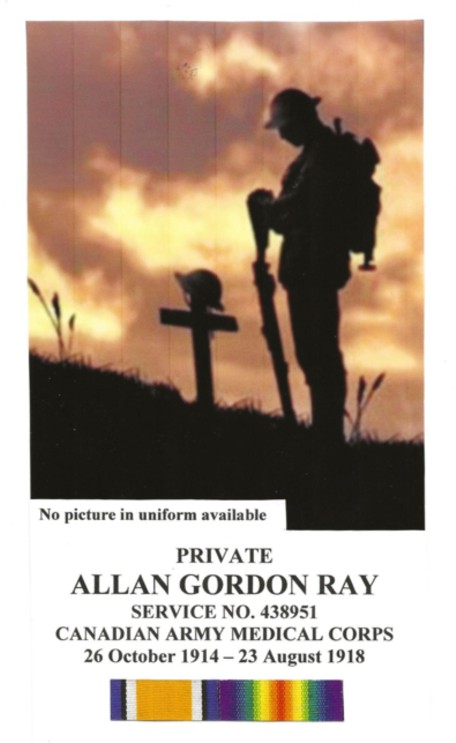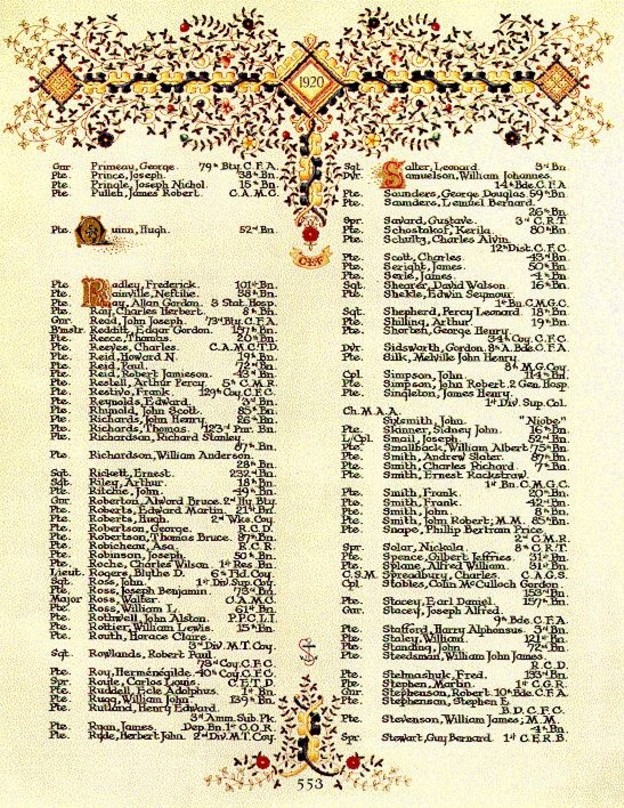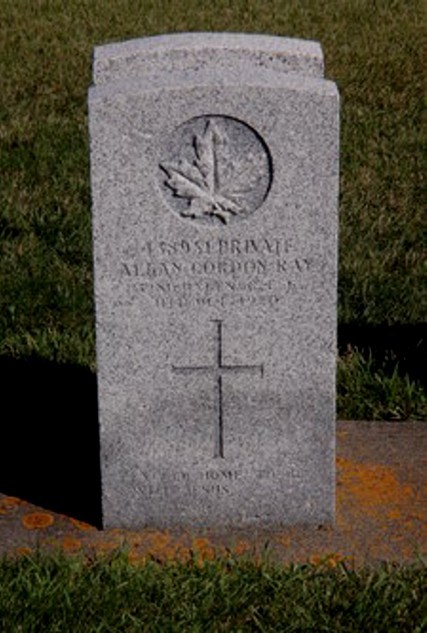
MILITARY HISTORY
Private Allan Gordon Ray – 438951 – Active Service (World War I)
On October 26th, 1914 Allan Gordon Ray completed the Attestation Paper for the Canadian Expeditionary Force (CEF). He was 29 years, and 6 months old, when as a single man, he enlisted for the duration of the War. Allan Ray indicated that he was born in Peterborough County (Norwood), Ontario, and gave his birth date as April 15th, 1885. The Attestation Paper does not indicate where he was educated or to what level. He indicated that he presently belonged to the 52nd Regiment Militia. As far as his Trade or Calling, he lists ”Cook”. Allan Ray was 5′ 10” tall, and had a 40” chest (expanded). He had a fair complexion, blue eyes, and fair hair. His medical examination took place October 24th, 1914 at Prince Albert, Saskatchewan. He had no medical issues or physical limitations, and as such he was deemed fit (Category A), for Overseas duty with the Canadian Expeditionary Force. His next-of-kin was listed as his mother, Mrs. Elizabeth Ray of 347 Kennedy Road, Winnipeg, Manitoba. Allan Gordon Ray signed the Oath and Certificate of Attestation on October 26th, 1914 at Prince Albert, Saskatchewan. The Certificate of Magistrate was signed by the Justice on October 26th, 1914, at Prince Albert, Saskatchewan. Allan Gordon Ray was taken-on-strength with the 28th Battalion, as a Private, and was assigned Regimental Service Number A-38951.
The Certificate of Officer Commanding Unit was signed October 26th, 1914.
What is interesting with this Military File is that there are two Attestation Papers. The first is stamped ”Discharged”, but there is no indication as to why.
There is a hand written note at the top of the second one: ”52nd Battalion (unreadable) Draft”.
On January 2nd, 1915 Allan Gordon Ray completed the second Attestation Paper for the Canadian Expeditionary Force (CEF). He was 29 years, and 9 months old, when as a single man, he enlisted for the duration of the War. He now shows his mother as living at Suite 27, Lorraine Blk, Winnipeg, Manitoba. He indicated that he did not presently belong to an active Militia. As far as ”have you ever served in any Military Force, he indicated the 3rd Canadian Mounted Rifles. Allan Gordon Ray signed this second Oath and Certificate of Attestation on January 2nd, 1915 at Dryden, Ontario. The Certificate of Magistrate was signed by the Justice on January 2nd, 1915 also at Dryden. Allan Gordon Ray was taken-on-strength, as a Private, with the 52nd Battalion. His Regimental Serial Number is now shown as 38951.
The Certificate of Officer Commanding Unit was signed January 2nd, 1915 at Dryden, Ontario.
His Regimental Service No. is now shown as 438951.
The Military File indicates that Private Allan Gordon Ray arrived in England September 13th, 1915. On the 14th, Pte. Ray was struck-off-strength from the 52nd Battalion, on transfer to, and was taken-on-strength with No. 1 Company, 12th Reserve Battalion at Shroncliffe, England. Shortly after arriving in England, there are a couple entries indicating that Private Ray was Absent Without Leave (AWL), and forfeited pay, as a result. No other disciplinary actions were taken.
Pte. Ray was admitted to Moore Barracks, Canadian Hospital from the 12th Canadian Reserve Battalion on December 1st, 1915 with ”Influenza”, and was discharged January 25th, 1916. He was struck-off-strength from 12th Reserve Battalion on transfer to, and taken-on-strength with the Canadian Army Medical Corps (CAMC), Moore Barracks, Canadian Hospital January 28th, 1916. On March 22nd, he was admitted to Moore Barracks, Canadian Hospital, at Shroncliffe, as a patient with what was diagnosed as ”Gastrolgia” (stomach problems). He was discharged March 26th
A note in the File, indicates that on April 29th, 1916 Pte. Ray was to be paid at Army rate. He was struck-off-strength from Moore Barracks Hospital on being transferred to, and taken-on-strength with the CAMC Training School, Dibgate Camp, Shroncliffe, June 6th, 1916. June 18th, he was admitted to Moore Barracks Hospital with what was diagnosed as ”Bronchitis”. On June 23rd, 1916 he was discharged from Hospital.
There are no entries in the Military File from June 23rd, 1916 to March 1st, 1917. It can be assumed that he was undergoing training as a Medical Aid.
On March 1st, 1917 Pte. Ray was struck-off-strength from the CAMC Training School on transfer to CAMC Depot at Westenhanger, which was north-west of Folkestone, England. March 1st, he was taken-on-strength at CAMC Depot at Westenhanger. The Military File indicates that March 15th, he was ”on command” waiting for instructions. Pte. Ray was struck-off-strength CAMC Depot – Westenhanger, on proceeding Overseas March 27th. He arrived at the Canadian Base Depot at Le Havre March 28th, 1917.
The CAMC Depot War Diary indicates that, on this date, 20 men proceeded Overseas.
April 10th, 1917 Pte. Ray was attached to (taken-on-strength) the Canadian Corps – Class ”TB” Temporary Base (Medical) for duty. On August 28th, he ”ceases to be attached to Canadian Corps (unreadable) on return to Canadian General Base Depot – Class ”A”. August 30th, he was taken-on-strength ”TB” Temporary Base (Medical) No. 1 Canadian General Hospital at Etaples, France.
The Military File provides no indication what his duties were with the No. 1 Canadian General Hospital at Etaples. Research indicates, that at the time of his arrival, the Hospital was staffed by 30 Medical officers, 70 nursing sisters, and 200 or so other ranks. Originally, the Hospital was comprised of ”Indian” pattern tents that were sloped on 4 sides. Five tents were joined end-to-end, on both sides of a central service tent. Although this arrangement was described as ”spacious and comfortable in the summer”. During heavy rain, which was common in the area, the slopped sides acted as gutters, allowing the rain to pour in between the tents, where they were joined together. The ”tie ropes and fabric of the tents were completely unsuitable during the winter weather in the region. The tents were described as cold and drafty”. A general move was underway to replace the tents with permanent ”hutments”. Prior to the arrival of Pte. Roy, the No. 1 Canadian General Hospital tents were being replaced. Through the connections that the Officer Commanding, a Colonel Thompson, had with friends back home in St. John, New Brunswick, the first of the ”New Brunswick Huts” had been occupied by patients, and were a welcome change.
October 18th, 1917 he was posted to No. 3 Canadian Stationary Hospital at Doullens, France. October 19th, he was taken-on-strength with No. 3 Canadian Stationary Hospital. On October 24th, he was admitted to No. 3 Canadian Stationary Hospital with Bronchitis. November 3rd, discharged to duty. November 9th, admitted to No. 5 Canadian General Hospital at Rouen, with what was diagnosed as Asthma. November 14th, he was admitted to 1st Southern General Hospital, Stourbridge Section, Birmingham, England. November 28th, transferred to Woodcote Park Convalescent Hospital, at Epsom. On December 4th, he was transferred to Manor (County of London) War Hospital, at Epsom.
January 11th, 1918 Pte. Ray was transferred to King’s Canadian Red Cross Convalescent Hospital Bushey Park, Hampton, England. March 13th, he was now at No. 5 Canadian General Hospital at Kirkdale with what is described as ”Nephritis”, which is an inflammation of the Kidney’s. April 15th, Pte. Ray was struck-off-strength from the CAMC Depot, at Shroncliffe, on being invalidated to Canada. Embarked for Canada, aboard the S.S. Araguaya on April 15th, 1918. arriving in Halifax April 25th. April 21st, he taken-on-strength Military District No. 3 Cleaning Depot in Kingston, Ontario. April 28th, 1918 admitted to Queen’s Military Hospital for further treatment. April 29th, granted leave with subsistence allowance to May 13th, . May 13th, admitted to Queen’s Military Hospital for Brochial Asthma and Nephritis. June 15th, Pte. Ray was granted leave with subsistence allowance to July 13th. August 20th, he discharged to duty with Casualty Company.
August 23rd, 1918 Pte. Allan Gordon Ray was discharged from the Canadian Expeditionary Force, at No. 3 District Depot (Kingston, Ontario) as being ”medically unfit for further War Service”.
The Military File indicates that Private Allan Gordon Ray was eligible to receive the Canadian Expeditionary Force Class A War Service Badge. The File indicates that Pte. Allan Gordon Ray was not eligible to receive the 1914-15 Star, but that he was eligible to receive the: British War Medal, and the Victory Medal.
According to the Military File, Private Allan Gordon Ray served a total of 3 years, and 10 months with the Canadian Expeditionary Force: approximately 1 year, 2 months, and 27 days in Canada; 1 year, 11 months in the U.K., and 7 months, and 16 days in France.
An excerpt from an article in Maclean’s by Barbara Ameil, September 1996:
”The Military is the single calling in the world with job specifications that include a commitment to die for your nation. What could be more honourable”.
PERSONAL HISTORY
ALLAN GORDON RAY
Allan Gordon Ray was born in Dummer Township on April 14, 1885, son of Albert John Ray and Elizabeth Miles. He grew up in Dummer Township, received his education in the local school and helped his father with carpentry work. Allan left home and took a job working on the railroad as a brakeman. On February 12, 1907, Allan married Catherine Katie Jane Peever in Fort William, Ontario. Catherine was the daughter of John Peever and Mary Frost.
On January 2, 1915 Allan went to Dryden and enlisted to serve his King and Country. At the time of his enlistment he was working as a cook and listed his next of kin as his mother Elizabeth Ray who was living in Winnipeg, Manitoba at that time. After the war, Allan was discharged on August 23, 1918 at No. 3 District Depot in Kingston, Ontario. He returned home to Calgary, Alberta where he later died in the Calgary Hospital on October 11, 1920, age 35 years. Allan is buried in Union Cemetery in Calgary, Alberta and is commemorated on Page 553 of the First World War Book of Remembrance.
Allan Gordon Ray was a member of Knox Presbyterian Church and is included on a Memorial Plaque that hung in Knox Presbyterian Church which remembers with honour their members who served in the Armed Forces during World War I. This plaque was later moved to the Sanctuary of Lakefield United Church on Regent Street in 1932 after the two churches merged to form Lakefield United Church.

FAMILY HISTORY OF ALLAN GORDON RAY
Allan Gordon Ray’s paternal grandparents were John Ray born in 1815 and his wife Elizabeth born in 1817. They had a family of six children David, John, Lottie, Albert John, Mary and Fannie Ray. John Ray passed away on April 17, 1881 and Elizabeth died on March 26, 1893; both are buried in Lakefield Cemetery.
Allan Gordon Ray’s maternal grandparents were Frederick Miles born in 1826 and Mary Elizabeth Rae. They married on March 17, 1848 and lived in Dummer Township. They had a large family of five children – Jane, James, William, John Rae, Elizabeth, Frederick & Robert Miles.
Allan Gordon Ray’s parents were Albert John Ray born in Smith Township in 1857 and Elizabeth Miles born in Dummer Township in 1859. They were married in Lakefield on May 3, 1876 and made their home in Dummer Township and Albert was a carpenter. They had a family of seven children – William Albert, Frederick John, Ethel, David, Roxie Blanche, Allan Gordon and Olive Gertrude Ray. Sadly Albert Ray passed away on December 19, 1889, age 32 years leaving Elizabeth with a young family. Albert is buried in the Lakefield Cemetery. After the death of their father, the older lads started migrating west. At the time of son Allan’s death, Elizabeth was living in Winnipeg, Manitoba.
